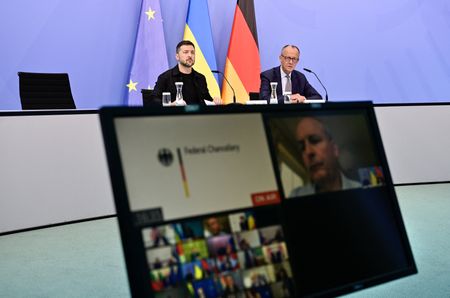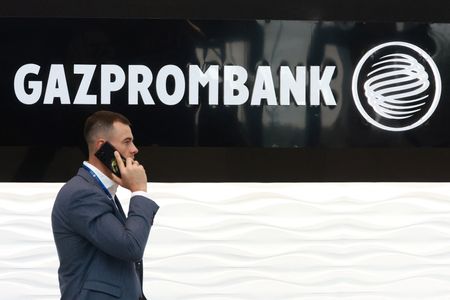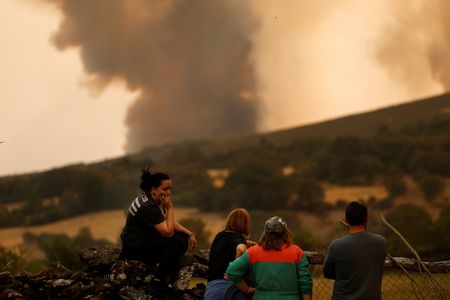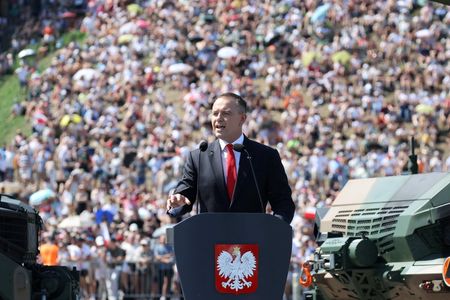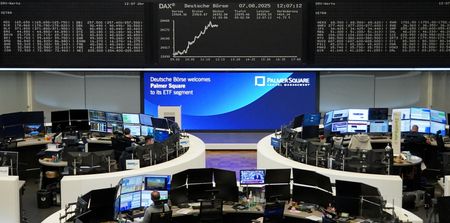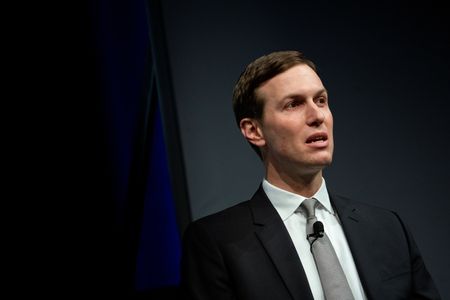By Marc Jones
LONDON (Reuters) -Investors are tempering expectations that Friday’s summit between U.S. President Donald Trump and Russia’s Vladimir Putin will deliver a significant breakthrough on the war in Ukraine despite some hopeful signs.
Ukraine’s government bonds – key indicators of the mood – rallied when news of the summit emerged this month but have largely stalled at a still-distressed 55 cents on the dollar amid the pre-meeting posturing.
Trump himself said it will be more of a “listening exercise” although he hopes it will go well enough for another involving Ukraine’s President Volodymyr Zelenskiy soon afterwards – and threatened “severe consequences” if it doesn’t.
Europe’s leaders meanwhile have been encouraged by Trump’s signals on participating in security guarantees, while Putin has praised Trump for “sincere efforts” to stop the hostilities.
Kathryn Exum, an analyst at emerging market-focused fund Gramercy, said the fact Ukraine’s bonds remain well below the highs they hit when Trump regained the White House despite their near 20% rally this month reflected limited market expectations.
“The bar is pretty high for any meaningful progress given the red lines of the parties seem deeply entrenched,” Exum said.
“I think the market is pricing in a symbolic truce,” such as on long-range missiles and drones, she added. “Ultimately though it doesn’t change the game for any side.”
‘MODEST POSITIVE’
Diliana Deltcheva, head of emerging market debt at Robeco, said EU leaders’ calls with Trump on Wednesday, when he offered a potentially significant but vague security offer, were a “modest positive”.
But she too thinks Friday’s summit, which is due to start at around 11 a.m. Alaska time (1900 GMT), is unlikely to yield substantive progress.
“We had a small overweight (in Ukraine bonds) but now we have neutralised it,” Deltcheva said. “From our position, it is too difficult to call the situation … there have been too many false starts.”
Ukraine’s massive funding needs mean it may require another debt restructuring at some point too, she added.
Analysts at U.S. investment bank JPMorgan said the chances for a peace deal this year remained “insignificant” and that even a full ceasefire appears unlikely.
Geopolitical analyst at research firm TS Lombard, Christopher Granville, however, thinks whatever its ostensible outcome, Friday’s meeting will mark the “definitive start of the concluding phase of the Ukraine war”.
“One way or the other, the situation is on a quickening path,” Granville said. Either the sides would find a path towards a lasting ceasefire, or the war would ratchet up and ultimately force the issue.
Ukraine’s bonds, part of a $20 billion restructuring last year, inched up on Friday, leaving them just below the five-month highs they hit earlier in the week.
Oil and gas prices have fallen over the last fortnight too, traders say, on hopes of a post-summit “peace dividend” that could avoid costly so-called “secondary” tariffs targeting major Russia crude buyers like India and China or even pave the way for the U.S. and Russia to start drilling in the Arctic.
Investment bank surveys show the majority of fund managers have a small “overweight” position on Ukraine’s bonds, although it has been reducing over the last six months.
Gramercy’s Exum said investors remain wary because Trump has repeatedly changed tack on the war.
His trolling of Zelenskiy as a “dictator” in February and the ugly Oval Office clash shortly afterwards, constituted “a wakeup call” for overly optimistic investors, she said.
Robeco’s Deltcheva described that meeting as “traumatising”, both in terms of the human aspect and for assumptions around the U.S. position.
“We all saw how Zelenskiy got treated and how Trump’s opinion changed,” which, she said, made it more difficult for investors to rely on Trump’s stance.
If Friday’s discussion surprises on the positive side though, “then we will probably have to react,” she said.
JPMorgan’s analysts meanwhile predicted Poland, Hungary and the Czech Republic’s currencies could surge as much as 4% if a full ceasefire happens, or drop 1% if the summit proves a flop.
(Reporting by Marc Jones; Editing by Giles Elgood and Joe Bavier)

